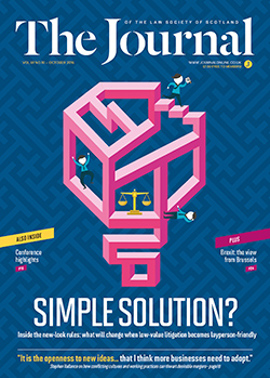Common areas: keep Pandora's box shut

Buying a house? Take a typical house on a housing estate and check its title for your client. If you’re lucky, you’ll have a title sheet with a plan attached showing the boundaries of the house within a bright red line. Does it have everything your client needs to live and enjoy their new home? A garden? A driveway? A grass lawn for a shed? It’s easy to check boundaries and what lies within them when you have a plan.
But, along with the house, you’ll also want to check what else your client owns. They’re not just moving into a home, they’re moving into a community, and you wonder who owns the roads they drive on to get to work, the play areas for their children, the grass park for their dog. How will you check your client has a neighbourhood to live in that is maintained and looked after? These common areas are owned by someone too.
In many estates, your client will own a share of the common areas (along with everyone else who lives on the estate). But, in older titles (pre-2009, roughly), these areas are often not mapped. Instead, a written description in their title might simply say that your client has a share, perhaps as a fraction, a percentage or a pro indiviso share, of the common ground without referring to a plan of that ground. If it does, and the title before you doesn’t have a plan to show you what your client owns, then you need to read the latest Registers of Scotland guidance, because your client may not own any of it at all, no matter what their title says.
Background
Three cases have examined the tricky question of how you define a common area: PMP Plus Ltd v Keeper of the Registers of Scotland 2009 SLT (Lands Tr) 2, Lundin Homes Ltd v Keeper of the Registers of Scotland 2013 SLT (Lands Tr) 73, and Miller Homes v Keeper of the Registers of Scotland (LTS/LR/2013/06, 24 March 2014). They have been covered before – see Todd, “Here comes the flood?” (Journal, October 2013, 33) – and we will not go over them again in detail. Their effect was to remind conveyancers that common areas were no different from any form of property – they had to comply with the 1979 Act (and now the 2012 Act) if the Keeper was to register them. This means, with a couple of exceptions mentioned below, that they must be mappable on the cadastral map.
Originally, the Keeper believed that a solution to this problem of mapping common areas could be found and she would need to change any title sheet which referred to unmapped common areas. In Keeper’s Update 27, issued in response to PMP Plus, she said: “The Keeper will not seek to improve the terms of wording in relation to rights to common areas in existing title sheets, nor to remove such wording, nor to insert an exclusion of indemnity in respect of such wording already appearing on a title sheet, unless an applicant specifically requests it and satisfactory evidence of the position is submitted.”
In her Additional Information Update following Lundin Homes, she said: “The Keeper does not propose, at this time, a general approach to remove superfluous wording in relation to common areas from existing title sheets nor to insert an exclusion of indemnity.”
The Keeper believed that prescription could provide a solution: “…it is possible that positive prescription may run on affected titles in the General Register of Sasines. At present positive prescription only runs on Land Register titles where indemnity has been excluded (that is not the case in titles affected by this update). However, the Land Registration etc (Scotland) Act 2012... changes the way that positive prescription operates in the Land Register so that it is more closely aligned with how positive prescription runs in the General Register of Sasines. The Keeper is currently considering the implications of this for titles affected... until that consideration is complete the Keeper does not consider it appropriate to rectify the Register unless an application is made for rectification. A further update will be published in due course” (our emphasis).
The latest guidance arrived in July 2016 as part of the Registers of Scotland Registration Manual. The Keeper’s advice could not be clearer: “Applications submitted on and after 8 December 2014, in so far as they purport to seek registration of a right of common ownership, must contain sufficient information to allow for mapping of the area(s) to be held in common ownership on the cadastral map. If an application does not meet the conditions of registration then such application must be rejected, subject to the exceptions for (1) common areas lying within tenement steadings and (2) applications where the description of the common area is founded on a deed recorded or registered prior to 8 December 2014, where the rights in common (if any) will be omitted from the title sheet of the plot in question.”
What this means is that the Keeper will remove any reference to ownership of common property from title sheets for all deeds submitted for registration after 8 December 2014. This position was confirmed by Registers’ letter at Journal, September 2016, 35: “Title sheets which include rights of ownership that the Lands Tribunal determined to be ineffective in the PMP Plus and Lundin Homes cases are inaccurate. Under the 2012 Act, the Keeper is of course bound to remove inaccuracies in the Land Register when their existence is identified, thus reflecting the true legal position.”
And, so that there is no doubt at all about what she intended, the Keeper also confirms in the online registration manual that all previous updates have been superseded (although Update 27 remains on the Register’s website unamended): “For the avoidance of doubt, previous policy arrangements whereby such ‘rights’ would continue to be entered on title sheets where the development in question had begun prior to 3 August 2009 do not apply.”
What does this mean in one sentence?
If a non-tenement title refers to ownership of a common area which cannot be mapped at the point it was originally conveyed then, on the basis of these updates, any reference to owning that common area will be removed from the title sheet.
What does it mean for sellers? They do not own a share of common areas, which reflects the PMP, Lundin and Miller Homes cases, and not only that, they have lost the twilight zone possible claim they had under previous guidance.
And for lenders? They will not have a security over that share of “common areas”.
And for purchasers? They will not be able to purchase a share of the “common areas”, nor will they know who will maintain them, or even if, say, a majority of owners are keen to maintain them, what rights exist (none?) for recovering maintenance costs.
What does this mean for solicitors?
In “Here comes the flood?” it was stated: “[Lundin Homes] has opened floodgates you may have thought closed. Given that thousands of properties are potentially affected, I hope the Keeper will revise Registers Update 27 to confirm that:
- common property that was defined by reference to a future uncertain event does not form part of any existing title; and
- provide guidance as to how she will deal with any applications for existing titles which might contain a ‘hole’.”
The Keeper has done that, and should be congratulated for providing the profession with a clear update. However, the consequences will be considerable.
Dealing with clients and lenders: The purchaser may not own what they think they will own, and lenders should be informed of any issues with ownership of common areas as part of your title report so that they can consider whether this will affect their valuations. This might be one for the Law Society of Scotland to approach the CML about. The prospect of trying to explain to residential (or any) lenders what is involved and why they should care, on a case by case basis, is unthinkable. Lenders as a group (CML) should be asked to take a view on this, and CML guidelines should say, for example, either that a possible PMP title need not be reported, or a simple tick box “possible PMP title” should be included in the certificate of title and, hopefully, agreement reached that that is acceptable.
In the meantime in our view the Society should recognise the practicalities and confirm that reporting is not mandatory and that a claim due to non-reporting is covered under the policy terms.
Dealing with management and factoring: The lack of ownership may have knock-on effects on the enforceability of any title conditions. While, in the short term, life will go on and factor fees will be paid, how long will it be before factors avoid “difficult” titles because they cannot guarantee they will be paid for their services? These cases represent a risk to their business, one they may not be willing to take. And if factors avoid these areas, who will maintain them?
Where next?
Borrowing the 2013 article title, the drip, drip of cases has led to a leak that cannot be fixed. We must deal with the consequences before they become an uncontrollable flood. We suspect a solution will ultimately lie in legislation – and we suggest the Scottish Law Commission or Scottish Government consider this further. Perhaps one answer may lie in adopting a model to allow conversion of title similar to that used by the Long Leases (Scotland) Act 2012, with long leases being replaced by PMP-affected titles.
If legislation is not an answer, some of the issues and solutions to consider, and needing to be considered in the interim, include title indemnity policies; developers as historic but accidental owners of “common areas”, unintentionally having a right and an unwanted obligation; corrective conveyancing by developers – a game for 100 or more parties; amenity and other rights over “common areas” disappearing; services running across “common areas” (what right is there for them – prescription perhaps?); common charges asked for and paid to factors in good faith when neither the instructors nor factors had any rights in the areas being maintained; public liability risk; QLTR as “owner of last resort”; ransom strips; title raiders; and, to complete the Land Register by 2024 (or 2019 for public body-owned land), will the Keeper end up having to identify all the rightful owners under Keeper-induced registration? – to name a few.
Luckily for us, Pandora left “Hope” in the box.
In this issue
- Legal protection of adults – an international comparison
- The UPC post-Brexit: unified, “emmental-ed”, or dead?
- Proof of purpose: IHT and APR
- Bankruptcy consolidated: what do I need to know?
- Dividends – compliant but challengeable?
- FGM mandatory reporting: an example to follow?
- Reading for pleasure
- Opinion: Neil Hay
- Book reviews
- Profile
- President's column
- Next pieces of the jigsaw
- People on the move
- Beginner's guide
- As simple as that?
- Excellence in action
- "That is not how we do it here"
- Rebranding in the digital age
- Brexit: Brussels in a holding pattern
- Common areas: keep Pandora's box shut
- Police: qualified experts?
- Is that overprovision policy watertight?
- Impact assessments still important
- The vital paper trail
- Scottish Solicitors' Discipline Tribunal
- Controlling interests: problem questions
- Law under orders
- Prisoner correspondence: a reminder
- Law reform roundup
- Society, Parliament revamp law student competition
- Foundation for aspiration
- Payment fraud: take five
- Ask Ash
- Better together?
- Paralegal pointers






